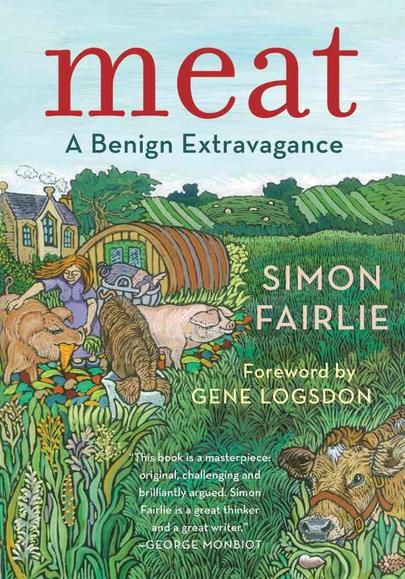Meat, a Benign Extravagance
Fairlie brings several decades of practical experience of farming, a critical quantitative approach and whole systems thinking. He does not defend our current industrialised systems of livestock farming and he is clear that, collectively, we need to eat less meat

Published by Chelsea Green, 2010
The increasing popularity and prominence of veganism gives Simon Fairlie’s 2010 book, Meat a Benign Extravagance, a topical relevance. Fairlie is one of the editors of the excellent magazine, The Land. He brings to this book several decades of practical experience of farming, a critical quantitative approach and whole systems thinking. He does not defend our current industrialised systems of livestock farming and he is clear that, collectively, we need to eat less meat. Meat is an extravagance, but one which from the point of view of the ecology and sustainability of agricultural systems can be benign (whether the killing of animals for meat is morally wrong a question that Fairlie does not address).
What Fairlie argues for is ‘default livestock’. Livestock have a place in agricultural systems: they consume wastes and surpluses, can be grazed on land that is unsuitable for crops or is part of a rotational system and they recycle nutrients. If we limit our livestock to those that can be fed in this way, and that are part of mixed agricultural systems, then their environmental impact is small. It is when meat consumption grows to the point where we need to grow crops specifically to feed to animals that its environmental impact balloons.
Fairlie gives oft-quoted statistics about livestock production a critical examination. He hunts down their sources and examines the assumptions that have gone into them. The 10:1 inefficiency of meat production (if you grow crops to feed to animals you need 10 times as much land to get an equivalent amount of food, compared to if you had eaten the crops directly) he finds to be broadly correct, at least for beef (chapter 3). However, this figure then needs to be revised downward to take into account: the ‘by-products’ that we get from livestock, such as leather, not provided by wheat or beans; that animals can eat things we can’t, such as grass, straw and the waste products from food processing; that the yield for a given area for a feed crop may be higher than one for a crop suitable for human consumption. In a later chapter (chapter 8) he points out that effective yields for organic vegan arable farming are reduced by the need to grow green manures for fertility, drastically reducing the land efficiency of vegan over mixed agricultural systems.
The idea that every kilogramme of beef requires 100,000 litres of water to produce turns out to be pretty much nonsense (chapter 7). The 18 per cent of greenhouse gas emissions attributable to the livestock sector (in a 2006 Food and Agriculture Organization report) generalises the emissions caused by deforestation in the Amazon to livestock in general, so is greatly over-inflated. Fairlie points out (on p.167) that switching from eating many types of animal products to a diet based on margarine and meat analogues made from Brazilian soya (also produced in the Amazon) would probably increase one’s contribution to deforestation and the greenhouse gas emissions associated with it. Fairlie sees ideological positions in favour of intensive farming, and that want to pin the blame for climate change on livestock rather than fossil fuels, as behind these statistics.
A similar critical examination is made of claims that argue the other way, for the beneficial impact of livestock. Soil is an important store of carbon and it has been claimed that the right sort of grazing regime, termed ‘mob grazing’ can lead to a significant increase in soil carbon levels, contributing to the sequestering of carbon dioxide from the atmosphere. Fairlie points out that such claims often fail to consider the whole system. Converting arable to grassland tends to increase soil carbon and going the other way decreases it. The carbon-balance for grassland needs to take into account any imported feed that the animals are given, for growing that feed will have led to the loss of carbon in soils elsewhere, while the fertilizing effect of the feed once digested by the animals will increase the carbon in the grazed land. Paying farmers carbon credits for locking up carbon in their soils is therefore likely to be fraught with difficulties.
Ultimately, Fairlie’s main argument for livestock having a place in our agriculture comes down to one about the sort of countryside and relationship to nature that we want. The logical conclusion to vegan agriculture is a segregation of our countryside: intensive arable areas protected by a big fence (to keep out pests and dangerous predators) from re-wilded land, where humans only go to look, not to participate. Arable farming involves little contact with nature:
“Most wheat, barley and potatoes are nowadays farmed without any need for the farmer to ever get down from the seat of his John Deere or his Dominator and touch the earth. But our meat is still farmed by men and women [there are a lot more women in livestock than arable farming] who handle their animals, who know how to straddle sheep and hoist cows on their feet when they are down, who trim their hooves and give them drenches and injections, who pull lambs in breach out of their mothers wombs’ and give them their first breath, and who are used to coming home with their overalls covered in muck.” (p.221)
He concludes that “A mixed farming system provides a more natural landscape than pure arable farming, is less mechanized and gives humans greater contact with nature” because “mixed farming, like nature, is complex, whereas pure arable farming ..... removes an entire order of creation from the system.” Animals eating living things is how nature works,
“by choosing not to eat nor to kill fauna, the vegan forces the greater part of the animal kingdom into exile from the human world, on the other side of the fence.” (p.222)
While dense in places this book is certainly well worth a read, whether you are a meat-eater, vegetarian or vegan. As a vegetarian it has not made me want to eat meat – the main reason I don’t eat it is more to do with not liking it very much, and as we collectively need to eat less meat I am leaving more for those who do appreciate it. However, it has made me question my avoidance of animal fats. In his chapter on ‘The Fat of the Land’ (chapter 6), Fairlie points out that in northern Europe, where it is difficult to grow plant oils (at least until rapeseed was introduced in the 1970s), people needed meat for the fat, not the protein. Up until about 1948 most fat available in the UK and other European countries north of the Alps was of animal origin; “the rise of vegetable oil is symptom of globalization” (p.56), though one inextricably linked to livestock production as the meal left over from pressing seeds to make vegetable oil is fed to animals. Animal fat used to be used in a wide range of things, from pastry, to biscuits to soap. That has now generally been replaced by palm oil, the production of which is complicit in rainforest destruction across East Asia, while beef fat collected in UK abattoirs is incinerated (p.23). I have found a soap made from lanolin, the fat in wool. But perhaps I should be cooking and baking with lard, dripping and suet instead of imported vegetable oils?
As well as editing The Land, Fairlie now runs a micro-dairy in Dorset (and, from the BBC video, keeps 'default' pigs and chickens). In the absence of a severe restriction on the use of fossil fuels he is campaigning for VAT to be charged on meat, so it is treated as a luxury food, like ice-cream or chocolate biscuits. Small farmers and retail businesses which are below the VAT threshold would be exempt, providing them with an advantage over larger producers and supermarkets.



